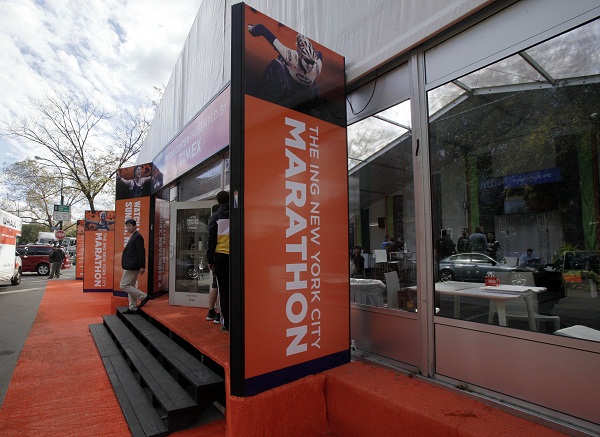NYC marathon to go on, despite storm of criticism

A man leaves the media center for the New York City Marathon in New York’s Central Park, Friday, November 2, 2012. The course for Sunday’s New York City Marathon will be the same since there was little damage but getting to the finish line could still be an adventure for runners from outlying areas. Such is life in Sandy’s aftermath — disrupted trains, planes, buses and ferries, flooded buildings, blocked roads and knocked out power. AP/Richard Drew
NEW YORK — New York City’s mayor defended the running of the world’s largest marathon Sunday in a city still searching for bodies from Superstorm Sandy and struggling for basic necessities like power, while some storm victims and other residents said holding the race would be insensitive and divert resources like exhausted police.
The marathon was expected to draw about 20,000 international runners — close to half of participants — who continued to arrive Friday in a city where hotels already held many storm refugees. They crowded the marathon expo, which was criticized after the heavy metal song “Rock You Like a Hurricane” was among the background music.
The marathon’s start is in Staten Island, the hardest hit part of the city, which made up almost half of the city’s death toll of at least 39.
“If there are any resources being put toward the marathon, that’s wrong. I’m sorry, that’s wrong,” said Joan Wacks, whose Staten Island waterfront condo was swamped by Monday’s storm surge. She called Mayor Michael Bloomberg “clueless without a paddle to the reality of what everyone else is dealing with.”
The New York Post tabloid devoted its front page to the headline “Abuse of Power!” and a photo of generators powering a marathon tent near the finish line in Central Park. The report said race organizers paid for the generator but that argued that officials should take them over for needy residents.
At a news conference, Bloomberg again defended his decision as a way to raise money for the stricken city and boost morale less than a week after Sandy struck and while Manhattan residents roughly south of the Empire State Building continued to live without power, hot water and other basic needs.
The marathon goes through all of the city’s five boroughs but doesn’t go through downtown. The marathon course had little damage.
“New York has to show we are here and we are going to recover … to give people something to cheer about in what has been a dismal week for a lot of people,” Bloomberg said.
He noted that his predecessor, Rudolph Giuliani, went ahead with the marathon two months after the Sept. 11, 2001 terrorist attack on the World Trade Center and said he Giuliani made the right decision.
The marathon generates an estimated $340 million in the city. In normal years, the race is lined for almost all the route with live bands, cheering neighborhood residents and hipster handmade signs like “Worst Parade Ever.”
Earlier this week, Bloomberg said the race wouldn’t divert resources from the storm recovery, noting electricity is expected to be restored to all of Manhattan by race day, freeing up “up an enormous number of police.”
Runners were conflicted. “It doesn’t feel good, coming to New York,” said Maria Eriksson, 27, who flew in Thursday from Sweden. “But the marathon has been planned for such a long time. And besides, it brings so much money to the city. That should help. What help would it be to cancel?”
The marathon’s sponsors and organizers have called it the “Race to Recover.” New York Road Runners, the race organizer, will donate $1 million and said sponsors have pledged more than $1.5 million.
One tradition of the marathon will have extra meaning as runners starting off from Staten Island and over the Verrazano-Narrows Bridge shed their jackets, sweatshirts and other warm clothes and toss them aside for charities and residents to gather and use.
“It’s hard in these moments to know what’s best to do,” New York Road Runners president Mary Wittenberg said. “The city believes this is best to do right now.”